Utilization of Construction Waste Recycled Powder as Filler in Asphalt Concrete
Abstract
:1. Introduction
2. Raw Materials and Experimental Methods
2.1. Raw Materials
2.2. Experimental Methods
2.2.1. Unsuitability Analysis of Directly Using RA in Asphalt Concrete
2.2.2. Applicability Analysis of RP as an Asphalt Filler
2.2.3. Design of Asphalt Concretes
2.2.4. Engineering Performance Evaluation of Asphalt Concretes
3. Results and Discussion
3.1. Unsuitability Analysis of Directly Using RA in Asphalt Concrete
3.2. Applicability Analysis of RP as an Asphalt Filler
3.3. Engineering Performance Evaluation of Asphalt Concrete
3.3.1. Moisture Damage Resistance
3.3.2. High-Temperature Deformation Resistance
3.3.3. Low-Temperature Crack Resistance
4. Conclusions
- Compared with common limestone aggregate, recycled aggregate (RA) presented 10.1% lower apparent specific gravity, 563.3% higher water absorption, 59.9% higher crush value and 55.1% higher abrasion value. These four basic technical properties do not meet the requirement of the Chinese technical specification. Therefore, RA cannot be directly used in asphalt pavement as aggregates, and convenient and low-cost utilization methods are needed for waste concrete.
- Compared with common limestone powder (LP), RP showed a coarser microtexture and contained rich floccules. These characteristics are beneficial for the interaction between RP and asphalt in asphalt mastic. The high SiO2 content mainly contributed by quartz minerals makes RA strongly acidic. Acidic mineral materials are not suitable for asphalt concrete. Therefore, RP is recommended for use in combination with other highly alkaline fillers.
- RMS and TSR results suggest that the appropriate blending ratio of RP and highly alkaline Portland cement (PC) in a hybrid filler system is 1:1. Preparing asphalt concrete with hybrid filler composed of 2%RP+2%PC can result in satisfactory moisture damage resistance, high-temperature deformation resistance and low-temperature crack resistance.
Author Contributions
Funding
Institutional Review Board Statement
Informed Consent Statement
Data Availability Statement
Acknowledgments
Conflicts of Interest
References
- Zhang, J.; Wang, M.; Wang, D.; Li, X.; Song, B.; Liu, P. Feasibility study on measurement of a physiological index value with an electrocardiogram tester to evaluate the pavement evenness and driving comfort. Measurement 2018, 117, 1–7. [Google Scholar] [CrossRef]
- Choudhary, J.; Kumar, B.; Gupta, A. Potential utilization of construction wastes in asphalt pavements as fillers using ranking framework. Constr. Build. Mater. 2021, 277, 122262. [Google Scholar] [CrossRef]
- Chen, Z.; Jiao, Y.; Wu, S.; Tu, F. Moisture-induced damage resistance of asphalt mixture entirely composed of gneiss and steel slag. Constr. Build. Mater. 2018, 177, 332–341. [Google Scholar] [CrossRef]
- Yang, C.; Wu, S.; Cui, P.; Amirkhanian, S.; Zhao, Z.; Wang, F.; Zhang, L.; Wei, M.; Zhou, X.; Xie, J. Performance characterization and enhancement mechanism of recycled asphalt mixtures involving high RAP content and steel slag. J. Clean. Prod. 2022, 336, 130484. [Google Scholar] [CrossRef]
- Xu, X.; Luo, Y.; Sreeram, A.; Wu, Q.; Chen, G.; Cheng, S.; Chen, Z.; Chen, X. Potential use of recycled concrete aggregate (RCA) for sustainable asphalt pavements of the future: A state-of-the-art review. J. Clean. Prod. 2022, 344, 130893. [Google Scholar] [CrossRef]
- Chen, Z.; Leng, Z.; Jiao, Y.; Xu, F.; Lin, J.; Wang, H.; Cai, J.; Zhu, L.; Zhang, Y.; Feng, N.; et al. Innovative use of industrially produced steel slag powders in asphalt mixture to replace mineral fillers. J. Clean. Prod. 2022, 344, 131124. [Google Scholar] [CrossRef]
- Cui, P.; Wu, S.; Xiao, Y.; Hu, R.; Yang, T. Environmental performance and functional analysis of chip seals with recycled basic oxygen furnace slag as aggregate. J. Hazard. Mater. 2021, 405, 124441. [Google Scholar] [CrossRef]
- Lima, M.S.S.; Thives, L.P. Evaluation of red mud as filler in Brazilian dense graded asphalt mixtures. Constr. Build. Mater. 2020, 260, 119894. [Google Scholar] [CrossRef]
- Zhang, X.; Zhang, B.; Chen, H.; Kuang, D. Feasibility evaluation of preparing asphalt mixture with low-grade aggregate, rubber asphalt and desulphurization gypsum residues. Materials 2018, 11, 1481. [Google Scholar] [CrossRef]
- Chen, Z.; Wu, S.; Xiao, Y.; Zeng, W.; Yi, M.; Wan, J. Effect of hydration and silicone resin on Basic Oxygen Furnace slag and its asphalt mixture. J. Clean. Prod. 2016, 112, 392–400. [Google Scholar] [CrossRef]
- Zhu, J.; Wu, S.; Zhong, J.; Wang, D. Investigation of asphalt mixture containing demolition waste obtained from earthquake-damaged buildings. Constr. Build. Mater. 2012, 29, 466–475. [Google Scholar] [CrossRef]
- Wu, R.; Xiao, Y.; Zhang, P.; Lin, J.; Cheng, G.; Chen, Z.; Yu, R. Asphalt VOCs reduction of zeolite synthesized from solid wastes of red mud and steel slag. J. Clean. Prod. 2022, 345, 131078. [Google Scholar] [CrossRef]
- Zhang, X.; Xiao, Y.; Long, Y.; Chen, Z.; Cui, P.; Wu, R.; Chang, X. VOCs reduction in bitumen binder with optimally designed Ca(OH)2-incorporated zeolite. Constr. Build. Mater. 2021, 279, 122485. [Google Scholar] [CrossRef]
- Xue, Y.; Wei, X.; Zhao, H.; Wang, T.; Xiao, Y. Interaction of spent FCC catalyst and asphalt binder: Rheological properties, emission of VOCs and immobilization of metals. J. Clean. Prod. 2020, 259, 120830. [Google Scholar] [CrossRef]
- Valdés, G.; Pérez-Jiménez, F.; Miró, R.; Martínez, A.; Botella, R. Experimental study of recycled asphalt mixtures with high percentages of reclaimed asphalt pavement (RAP). Constr. Build. Mater. 2011, 25, 1289–1297. [Google Scholar] [CrossRef]
- Leng, Z.; Sreeram, A.; Padhan, R.K.; Tan, Z. Value-added application of waste PET based additives in bituminous mixtures containing high percentage of reclaimed asphalt pavement (RAP). J. Clean. Prod. 2018, 196, 615–625. [Google Scholar] [CrossRef]
- Ossa, A.; García, J.L.; Botero, E. Use of recycled construction and demolition waste (CDW) aggregates: A sustainable alternative for the pavement construction industry. J. Clean. Prod. 2016, 135, 379–386. [Google Scholar] [CrossRef]
- Hu, J.; Qian, Z.; Huang, Q.; Liu, P. Investigation on high-temperature stability of recycled aggregate asphalt mixture based on microstructural characteristics. Constr. Build. Mater. 2022, 341, 127909. [Google Scholar] [CrossRef]
- Xu, X.; Leng, Z.; Lan, J.; Wang, W.; Yu, J.; Bai, Y.; Sreeram, A.; Hu, J. Sustainable practice in pavement engineering through value-added collective recycling of waste plastic and waste tyre rubber. Engineering 2021, 7, 857–867. [Google Scholar] [CrossRef]
- Leng, Z.; Padhan, R.K.; Sreeram, A. Production of a sustainable paving material through chemical recycling of waste PET into crumb rubber modified asphalt. J. Clean. Prod. 2018, 180, 682–688. [Google Scholar] [CrossRef]
- Datta, S.D.; Rana, M.J.; Assafi, M.N.; Mim, N.J.; Ahmed, S. Investigation on the generation of construction wastes in Bangladesh. Int. J. Constr. Manag. 2022, preprint. [Google Scholar] [CrossRef]
- Taherkhani, H.; Bayat, R. Investigating the properties of asphalt concrete containing recycled brick powder as filler. Eur. J. Environ. Civ. Eng. 2022, 26, 3583–3593. [Google Scholar] [CrossRef]
- Chen, M.; Lin, J.; Wu, S. Potential of recycled fine aggregates powder as filler in asphalt mixture. Constr. Build. Mater. 2011, 25, 3909–3914. [Google Scholar] [CrossRef]
- Wu, S.; Zhu, J.; Zhong, J.; Wang, D. Experimental investigation on related properties of asphalt mastic containing recycled red brick powder. Constr. Build. Mater. 2011, 25, 2883–2887. [Google Scholar] [CrossRef]
- Zhang, Z.; Sha, A.; Liu, X.; Luan, B.; Gao, J.; Jiang, W.; Ma, F. State-of-the-art of porous asphalt pavement: Experience and considerations of mixture design. Constr. Build. Mater. 2020, 262, 119998. [Google Scholar] [CrossRef]
- Pang, L.; Wu, S.P.; Xie, J.; Hu, D.M. Investigate of performance of asphalt concrete with gneiss. Key Eng. Mater. 2010, 417–418, 497–500. [Google Scholar] [CrossRef]
- Chen, Z.W.; Wang, P.; Zhou, X.X.; Wu, S.P. Effect of Portland cement on moisture resistance of gneiss based HMA. Key Eng. Mater. 2014, 599, 120–124. [Google Scholar] [CrossRef]
- Ministry of Transport of the People’s Republic of China. Technical Specifications for Construction Highway Asphalt Pavements; JTG F40; Ministry of Transport of the People’s Republic of China: Beijing, China, 2004. (In Chinese)
- Ministry of Transport of the People’s Republic of China. Standard Test Methods of Bitumen and Bituminous Mixtures for Highway Engineering; JTG E20; Ministry of Transport of the People’s Republic of China: Beijing, China, 2011. (In Chinese)
- Ministry of Transport of the People’s Republic of China. Test Methods of Aggregate for Highway Engineering; JTG E42; Ministry of Transport of the People’s Republic of China: Beijing, China, 2005. (In Chinese)



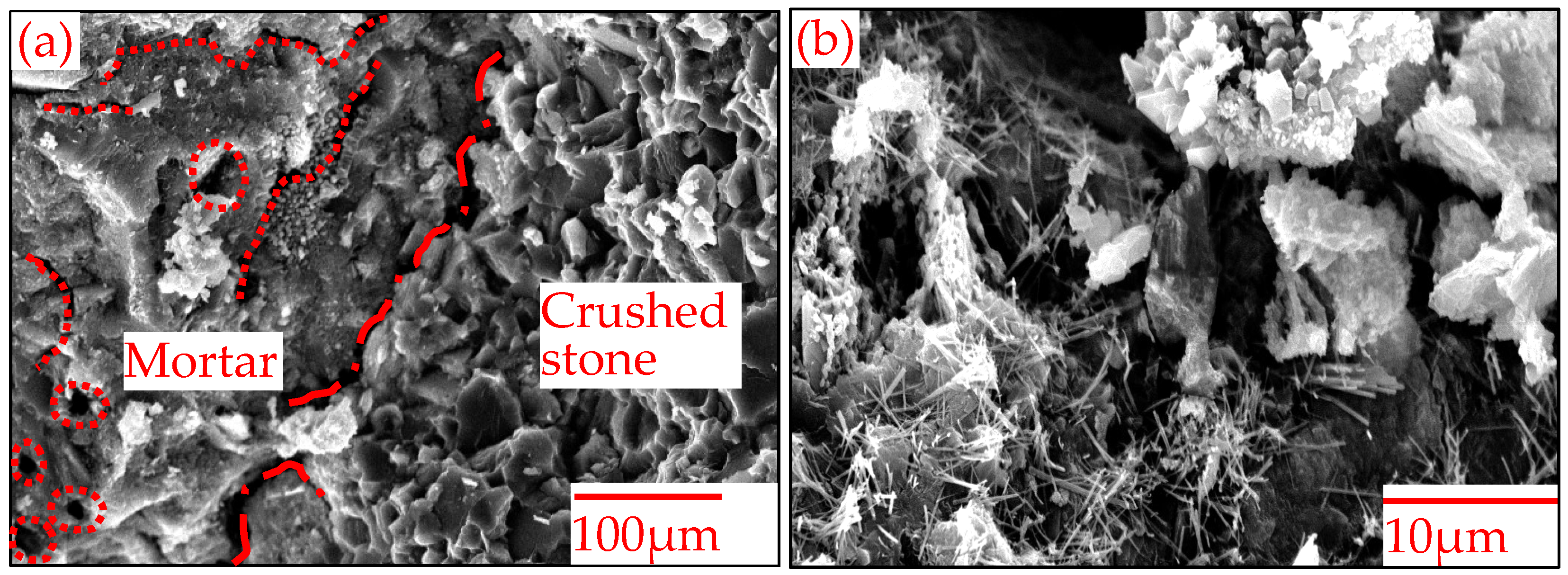
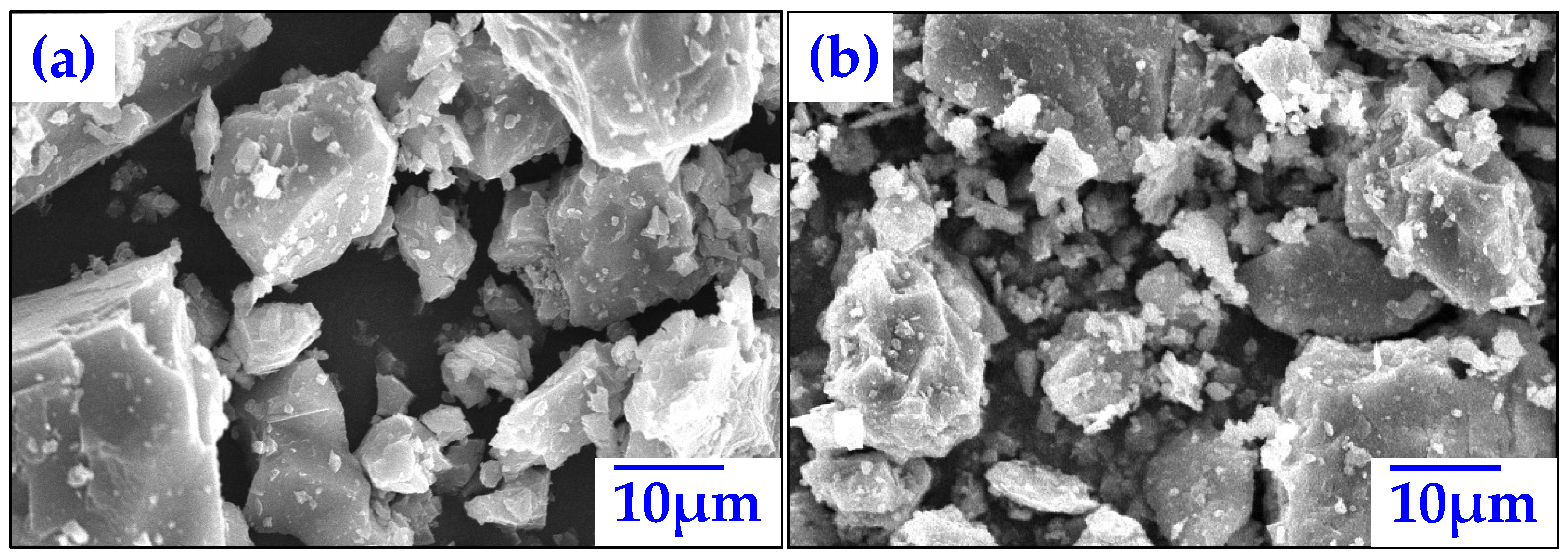
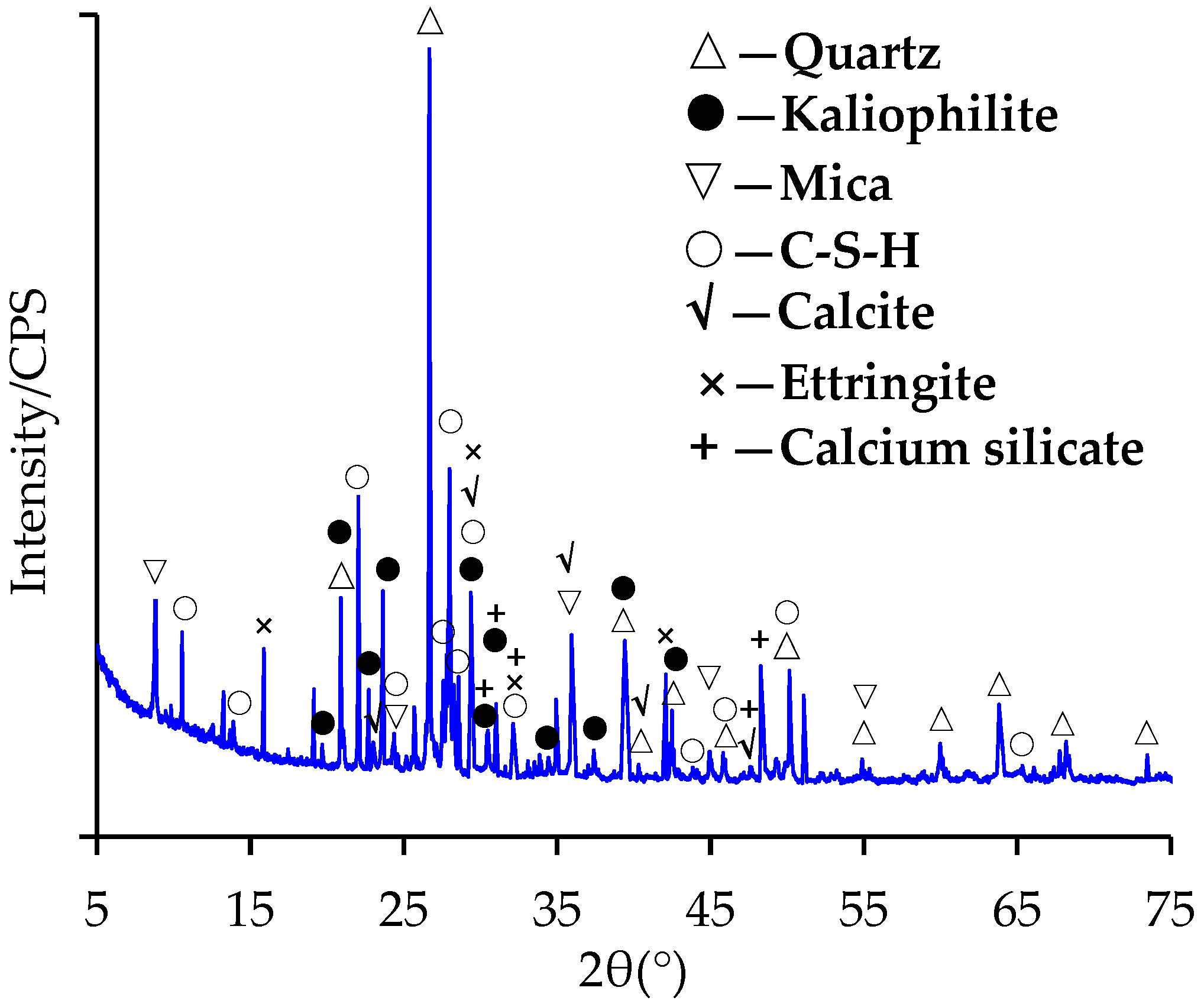
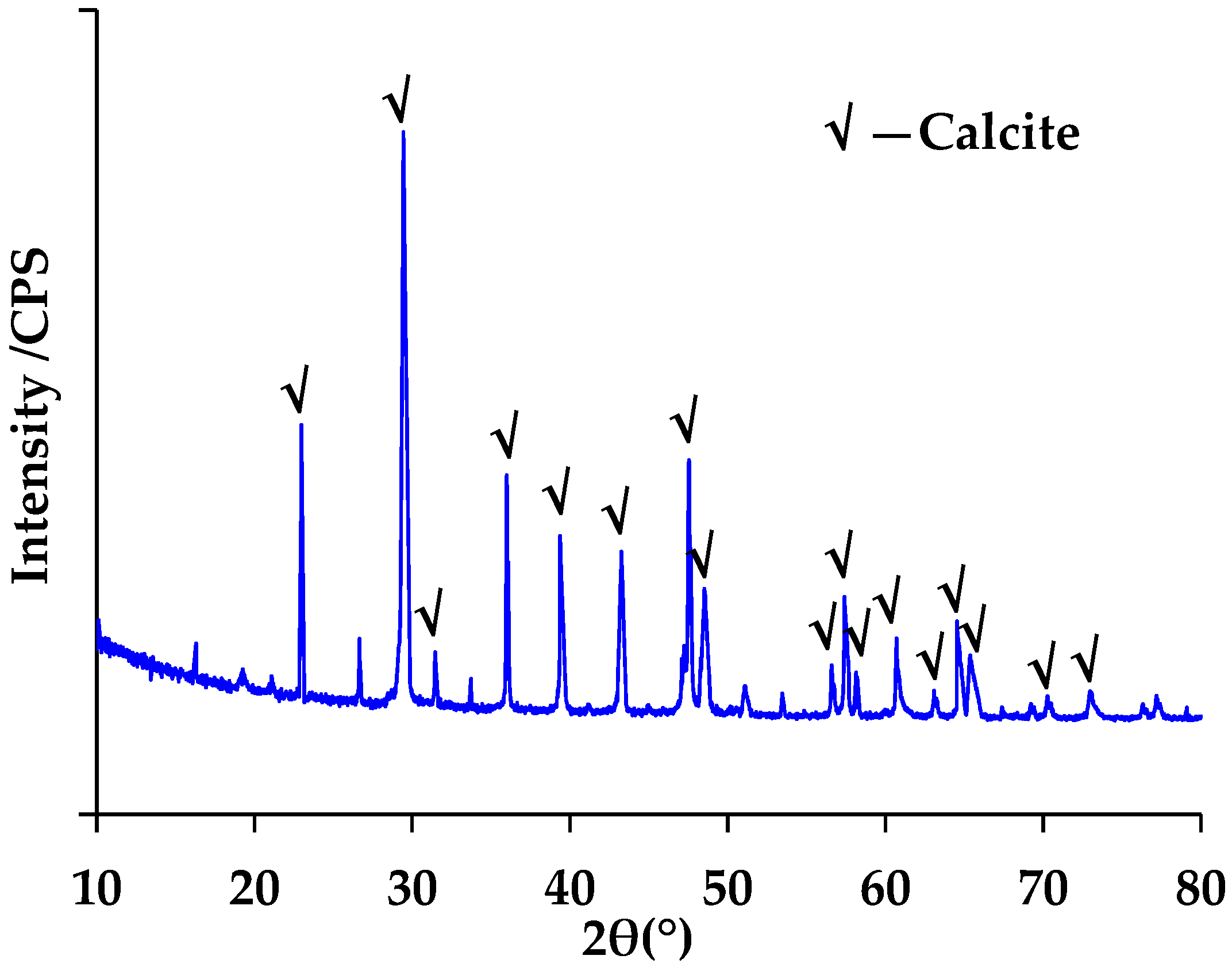

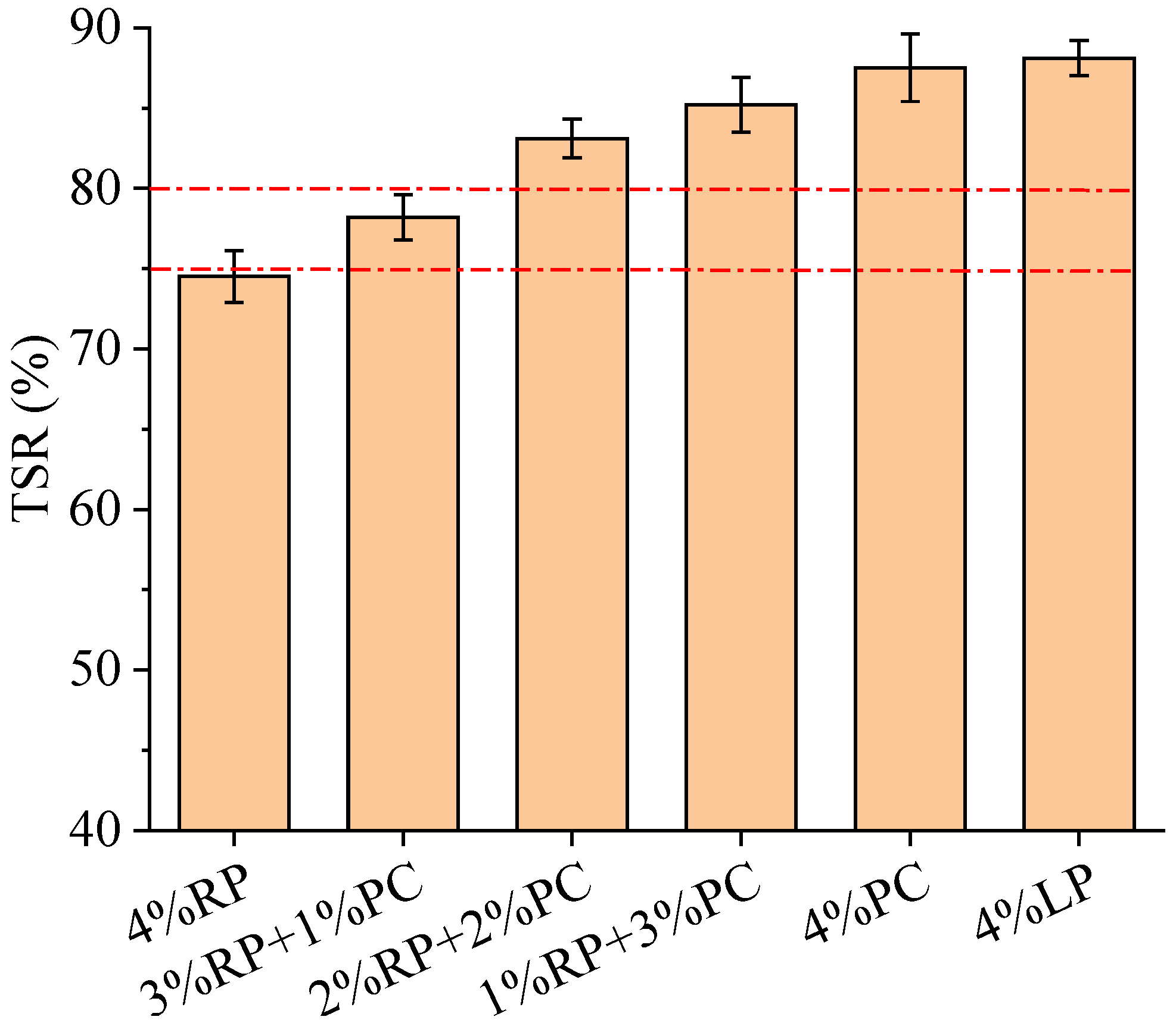
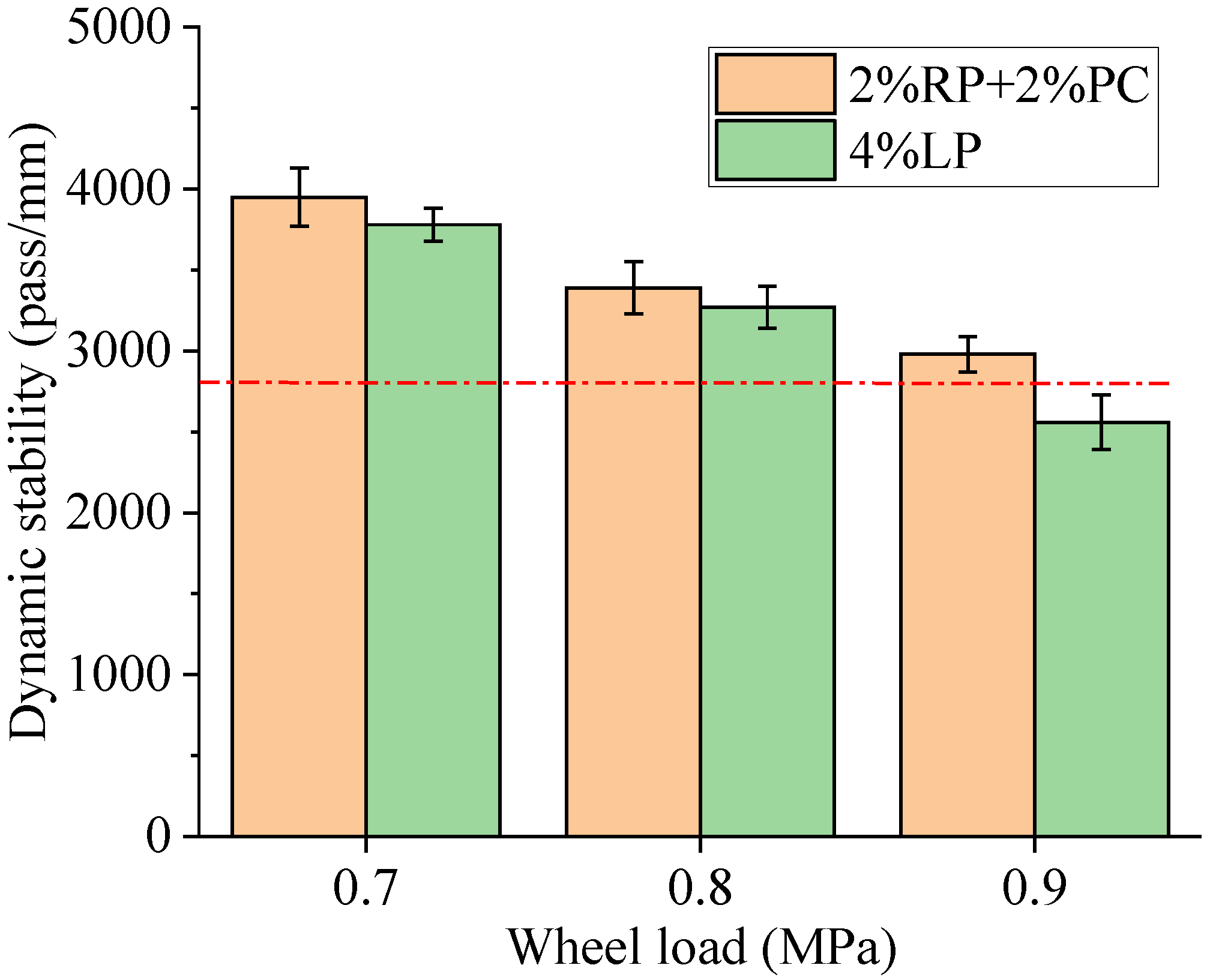
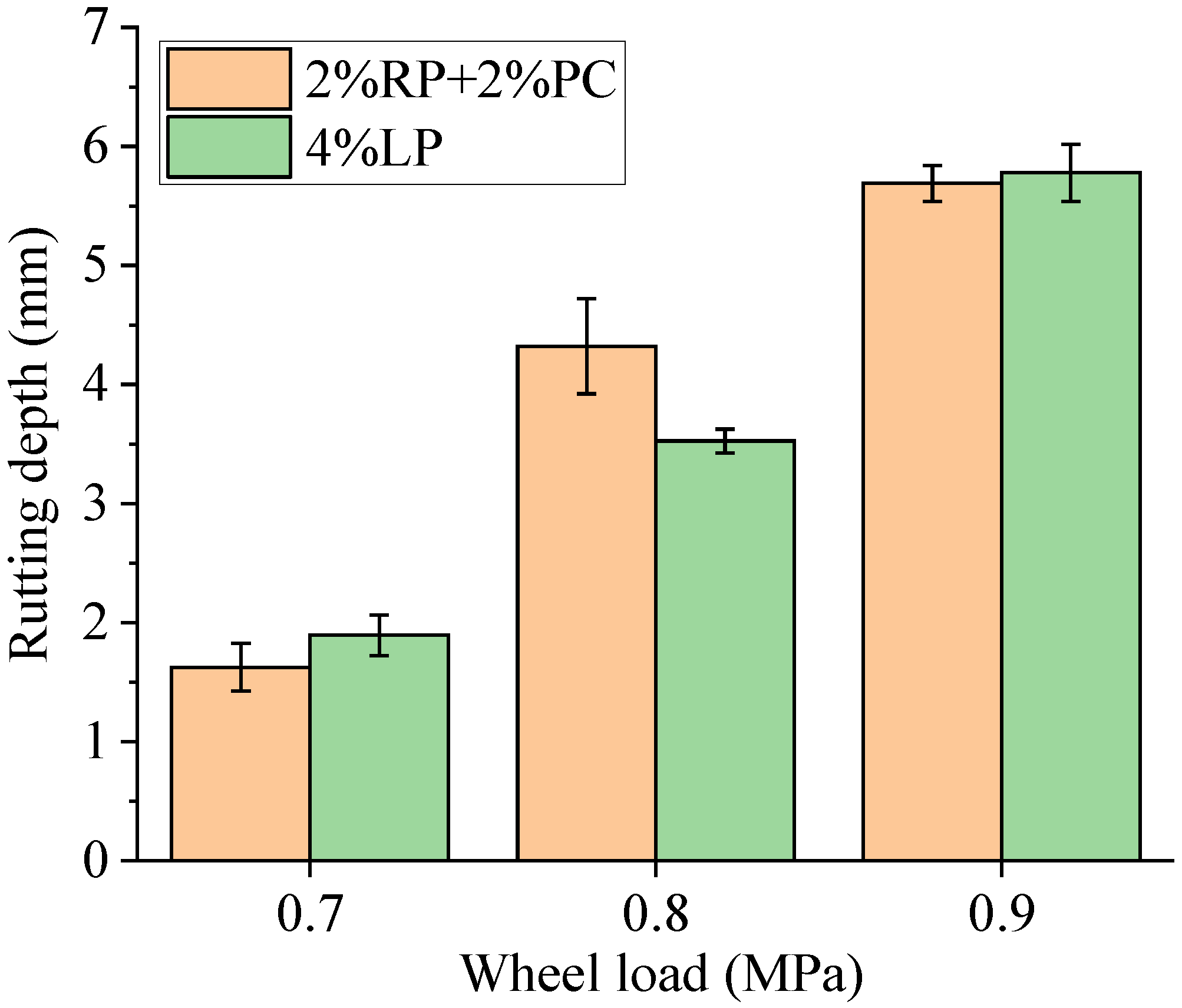
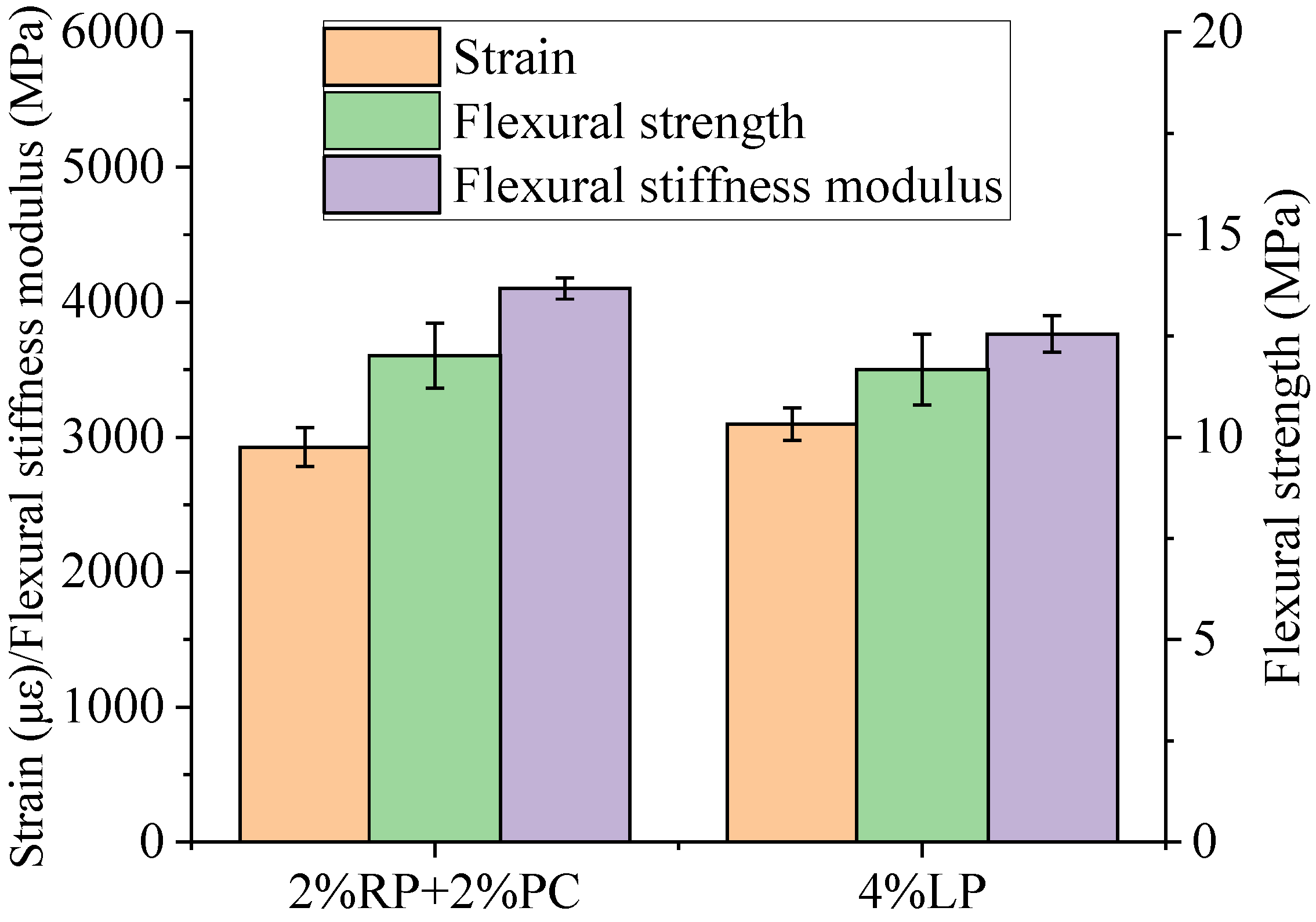
| Property | Results | Requirement |
|---|---|---|
| Apparent specific gravity | 2.711 | ≥2.5 |
| Water absorption (%) | 1.3 | ≤2 |
| Fine aggregate angularity (%) | 58 | ≥30 |
| Sand equivalent (%) | 66 | ≥60 |
| Property | LP | RP | PC | Requirement | |
|---|---|---|---|---|---|
| Specific gravity (g/cm3) | 2.715 | 2.588 | 3.011 | ≥2.5 | |
| Percent passing (%) | 0.6 mm | 100 | 100 | 100 | 100 |
| 0.15 mm | 92.1 | 95.2 | 93.7 | 90–100 | |
| 0.075 mm | 86.2 | 88.5 | 88.1 | 75–100 | |
| Property | Results | Requirement |
|---|---|---|
| Softening point (°C) | 80.2 | ≥60 |
| Penetration (25 °C; 0.1 mm) | 58.8 | 40–60 |
| Ductility (5 °C; cm) | 37.8 | ≥20 |
| Viscosity (135 °C; Pa·s) | 0.955 | ≤3 |
| Elasticity résumé (25 °C; %) | 77 | ≥75 |
| Asphalt Concrete | Coarse Aggregate | Fine Aggregate | Filler |
|---|---|---|---|
| 1 | 55% limestone | 41% limestone | 4%RP |
| 2 | 3%RP+1%PC | ||
| 3 | 2%RP+2%PC | ||
| 4 | 1%RP+3%PC | ||
| 5 | 4%PC | ||
| 6 | 4%LP |
| Chemical Composition | RP (%) | LP (%) |
|---|---|---|
| SiO2 | 52.36 | 1.03 |
| Al2O3 | 10.56 | 0.85 |
| CaO | 12.72 | 50.65 |
| Fe2O3 | 5.72 | 0.45 |
| MgO | 1.12 | 0.46 |
| K2O | 4.95 | 0.21 |
| SO3 | 3.48 | 0.17 |
| LoI | 7.85 | 42.21 |
Publisher’s Note: MDPI stays neutral with regard to jurisdictional claims in published maps and institutional affiliations. |
© 2022 by the authors. Licensee MDPI, Basel, Switzerland. This article is an open access article distributed under the terms and conditions of the Creative Commons Attribution (CC BY) license (https://creativecommons.org/licenses/by/4.0/).
Share and Cite
Guo, Z.; Chen, Z. Utilization of Construction Waste Recycled Powder as Filler in Asphalt Concrete. Materials 2022, 15, 5742. https://doi.org/10.3390/ma15165742
Guo Z, Chen Z. Utilization of Construction Waste Recycled Powder as Filler in Asphalt Concrete. Materials. 2022; 15(16):5742. https://doi.org/10.3390/ma15165742
Chicago/Turabian StyleGuo, Zemeng, and Zongwu Chen. 2022. "Utilization of Construction Waste Recycled Powder as Filler in Asphalt Concrete" Materials 15, no. 16: 5742. https://doi.org/10.3390/ma15165742





